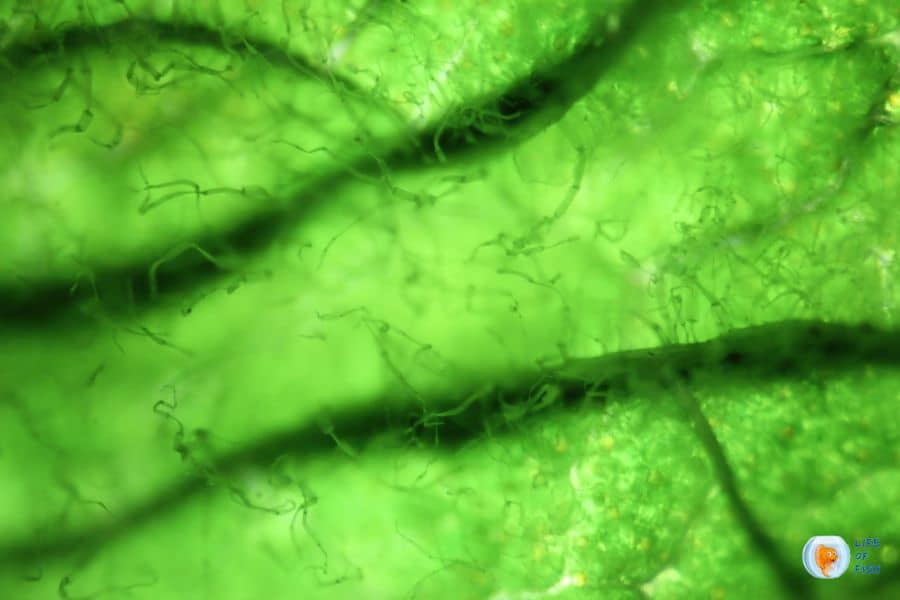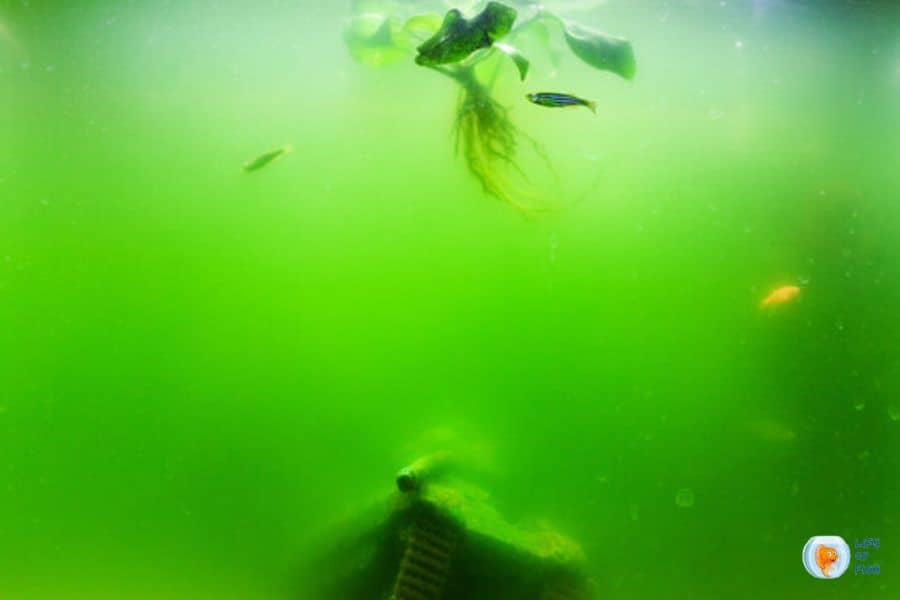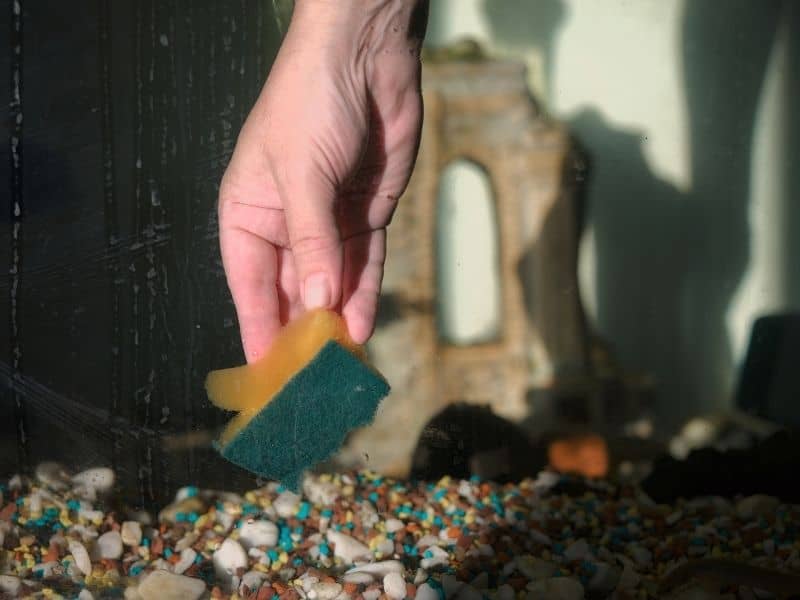Although the Green dust algae do not harm your fish or plant, it certainly harms the scenic value of your aquarium. So you should know How to remove algae from fish tank glass. Since you cannot see through the glass you always should peep through the top of your tank. You can follow the below steps to get rid of the green dust algae.
The first thing you should do is check your nutrients. For this, you need an aquarium test kit. With this instrument, you can check all the essential nutrient concentrations (phosphates, nitrates, nitrites, etc. ) including water parameters such as pH.

How To Remove Algae From Fish Tank Glass (Steps)
Jump To
As mentioned above you should check the water quality of the tank. The preferred conditions are noted below.
- CO2: 20 – 30 mg/l
- Nitrate (NO3): 10 – 25 mg/l
- Potassium (K): 5 – 10 mg/l
- Phosphate (PO4): 0.1 – 1 mg/l
- Magnesium (Mg): >10 mg/l
Cross-check with the suitable water parameters and address if there is any nutrient imbalance.
Then vacuum the substrate. The substrate of the fish tank is where the fish waste, uneaten foods, and detritus are accumulating. You need to clean the filter pads or chemical media to facilitate efficient filtration. You may need to replace them if they are not in good condition
The next step is to stop the spores from spreading.
The green dust algae are spread by algae spores. They are tiny and you cannot see them. But they are excited and actively participate in the spreading of green dust algae. You cannot accommodate manual or mechanical procedures to destroy them as you cannot see or touch them. Aquarists suggest using UV sterilizers to get rid of them. UV sterilizer is a little clever device that kills the tiny living things that float in your clean water using a tank light. It is generally used to clear up bacterial blooms and it is proven that it can be used to kill green dust algae spores.
If you don’t have a UV sterilizer you can use a fine filter media, preferably a 100-micron polishing pad to trap the algae. After performing the above practice you can be assured that no more green dust algae spores are present in the water.
The next step is to remove the existing green dust algae in the aquarium.
Manual removal is one method to remove the green dust algae. Many aquarists complain that it is hard to remove them completely while some do this effortlessly. The secret is there is a trick to remove algae.
According to the researchers, green dust algae has a life cycle. If you remove them early, they will appear again within a few days. So, you have to monitor the first appearance of the algae and wait until when it is in its old age. For that, you should let your green algae growth. It may not be pleasing to see your tank covered with green moss for weeks. But you have to do it in order to get rid of the green dust algae.
According to the researchers, green dust algae get old within 4-5 weeks. Therefore, you have to wait at least 4 weeks from the time that you notice the very first appearance of green dust algae. You must be very patient to see your tank completely messed up with green dust algae.
During this time, you should do regular water changes as usual. However, be careful, not to disturb the green algae that cling to the glass of the tank.

The next step is to drain your tank
Drain your tank until you see 3-4 inches of green dust algae exposed above the dechlorinated water line. They grab some paper towels and carefully wipe away the green dust algae. Make sure none of it falls back into the aquarium. You can do this in sections and when your paper towel is full of algae, trash it and use a fresh towel for the next section.
You should repeat the procedure until 25% of the water remains in your aquarium. Remove any equipment in the aquarium such as heaters, or powerheads when they fall below the water line. Clean this equipment separately. Many aquarists found this a messy task; especially, cleaning the instrument like a circulating fan.
Then pay attention to the green dust algae that are sitting below the water line. Take a piece of cloth and slowly wipe it up. You should start the process at the bottom of the aquarium and wipe it upward. Don’t be in this step. You should clean the glass completely as well as avoid bumping the green dust algae into the water as much as possible.
Once you completely clean the glass, lightly spray 3% of hydrogen peroxide (H2O2) onto a fresh cloth and wipe it over the cleaned sections of the tank glass. This will kill any remaining spores or algae still clinging to the tank glass. The cleaning procedure is almost complete at this level.
Next is refilling
Then, refill your tank. As the last step, use the UV light to kill any spores still remaining in the water. Check for the nutrient balance in the water. You can know whether you have succeeded or not in a few days.
The other method to remove green dust algae is to occupy a few of the algae eaters. The shrimp nerite snail and siamese algae eaters are renowned algae eaters. However, the algae eaters cannot eliminate it completely by themselves. They may nibble off chunks of algae here and there but still, you can see the chunks of algae in the aquarium glass. In addition, you may see some hilarious patterns arise from their nibbling off.
Further, the snails you have chosen for the algae removal may increase their population by thrice in a few weeks’ time, and then seeing hundreds of snails can be another eye sore. Therefore, if you need to make your tank algae-free, you need to get a fish with a big appetite. The bristle nose pleco may be a good choice.
how to remove algae from fish tank decorations
There are a number of methods to get rid of algae from fish tank decorations. You can use vinegar, citric acid, and muriatic acid as a cleaning agents. Before you go ahead check and fix the following first.
- Test the water quality and make them in the correct conditions. This is because this is the primary reason to grow algae. If you do not eliminate the reason, you may need to clean the tank very often
- Remove algae from the glass walls and the lid to prevent having algae from time to time
- Vacuum the substrate. The substrate of the fish tank is where the fish waste, uneaten foods, and detritus are accumulating.
- Finally, you need to clean the filter pads or chemical media to facilitate efficient filtration. You may need to replace them if they are not in good condition
The steps to clean the algae from the decoration are as below.
- Identify and take out all the decorations in your fish tank which have algae growing on them
- Scrub the decorations with a small and stiff brush . Wash the scrubbed decorations under running hot water. Make sure , your brush can reach all the crevices and cracks of the ornaments and rocks. Clean and remove as much as algae with the brush and hot water
- Then submerge all the decorations in a very hot water bucket to remove if there any remaining spores
- Mix some good bleaching agents into the water. About half a cup of bleach powder for every gallon of water will suffice.
- Then soak all the decorations for 15-60 minutes. The reason to do this is to loosen the algae that is stuck in the crevices and kill off any remaining algae. To make sure , there is no algae remaining on the decorations , brush and scrub them out again.
- Rinse the decorations thoroughly under running cold water. Now you can put the decoration into the tank.

Natural way to remove algae from fish tank glass?
There are two natural ways to remove algae from your fish tank.
Preventing Algae Build-Up
Though algae growing is a real eyesore, you can get rid of them using natural remedies.
1. Light reduction As described before, one of the major reasons for the algae build-up is a high amount of light.
You can reduce the light in different ways. If you put your tank in an area with high sunlight intensity, you can put it in another area. Also, you can cover it with dark-colored paper. if you are using artificial light, use light with low intensity. However, this may badly affect a planted tank as well as reef tanks as they need light to grow and thrive.
2. Food Reduction
The other main reason for the algae growth is the remaining food particles in the aquarium. Make sure you only feed a substantial amount of food to your pets. Another advantage of this method is saving on fish food. However, you should ensure that your pets get a sufficient meal. Some fish varieties need frequent feedings. Less food in reef tanks means fewer leftovers for the scavengers. This would raise the stress of the scavengers like hermit crabs and they would nip corals or attack other fish. Therefore, whatever thing you do make sure that will not harm the food cycle and stability in your tank.
3. Frequent water changes
The aim of frequent water changes is to reduce the nutrients in the water and reduce algae spores. However, this will cost you more than other natural methods and also this is not a good method for large tanks
4. Check your filter/protein skimmer
These are the main instruments that make the water clean in your aquarium. Check if they work properly and replace the mal-working filters /skimmers
5. Add natural aquarium cleaners
Nature will provide you with the best answers for the algae buildup. It is an algae-eating species. These species feed on algae and help to clear your tank of excess algae and leftover food. However, make sure the species you wish to add to the tank is compatible with the tank residents.
Add algae-eating fish to the tank
Freshwater Scavengers and Algae-eating Fish
1. Cory Catfish:They are Bottom-dwelling scavengers and can be kept with other peaceful fish
2. Loaches: There is a range of loach varieties and Kuhli Loaches, Dojo Loaches, Dwarf Loaches, and Sucker Loaches are some of them. However, sucker loaches may nip other fish when they mature. Therefore, be careful if you occupy them to control algae
3. Chinese Algae Eaters: they are sucker-mouthed bottom feeders. However, they are aggressive when they mature.
4. Pictus Catfish: It is good to have 3-4 of them because they thrive as a group.
5. Redfin Prochilodus: They are colorful fish and add beauty to the tank aside from scavenging
6. Plecostomus Catfish (commonly known as Plecos): They are the most popular fish scavenging fish species. They have a big appetite and they are more efficient algae eaters than others
Apart from them Mollies, Ameca Splendens, Otocinclus, American Flagfish, and some species of African Cichlids are also used as algae scavengers
Saltwater Fish
1. Blenny: Bottom scavengers
2. Sturgeon and Tang: occasionally feed on algae
5. Goby: Bottom-dwelling scavengers
Apart from fish species, certain species of crabs, shrimps, and snails are renowned as scavengers.
Crabs: Hermit crabs, Arrow Crabs, Fiddler Crabs, Sally Lightfoot Crabs
Snails: Turbo Snails,
Shrimps: Coral Banded shrimp, Cleaner Shrimp, Red or Fire Shrimp, Bamboo Shrimp, Blue Crayfish, and Prawns (long-armed)
Sea Urchins, starfish, and brittle stars are also eating algae.
However, you should study the aquarium type(saltwater/freshwater ), other fish you wish to put in the aquarium, and the behavior of scavengers thoroughly otherwise you will end up losing your fish.

Related question
What causes green algae on aquarium glass?
As their name suggests green algae is a green color organism. They can be photosynthetic like the other plants do and are characterized by having chlorophylls a and b as the major photosynthetic pigments.
Therefore, the main reason for green algae overgrowth is plenty of sunlight! The other main reason is too many nutrients in the water. If you are having too much algae growth, it could be caused by the following reasons
- Leaving house lights on too long
- The tank receives too much direct sunlight
- Too much fish food
- Not changing the water regularly
- Allowing too many nutrients to build up in the water
What is green dust algae and how do you identify it?
Green dust algae( GDA) look like tiny green dust as its name suggests. You will first notice it is like green icing sugar. No longer from the first appearance, they will conquer the glass of your tank forming a thick green layer. Many people confuse Green spot algae (GSA) with green dust algae. The key feature to identify green dust algae is it forms a green slime covering the glass while the Green spot algae grow in spots. Also, Green dust algae can be easily scraped with your finger while it is hard to remove green spot algae. GDA usually forms on glass or hardscapes such as solid decorations.
The green dust algae are actually small individual cells that are capable of moving. Green dust algae are considered one of the hardest algae types to control. No matter how many times you scrape out the green dust algae from the glass or where it covers, it returns to the same spot. This is because these small individual cells can move and if you scrape it, it may move to another spot or come back to the same spot and carry on growing. However, they do not make your water green unless they are not disturbed. You can see the water is crystal clear after carefully removing the green dust algae from the glass
The main reason is the low carbon dioxide and low nutrients in your aquarium. It is a tough job to remove it when it begins to form. The best way to get rid of green dust algae is to wait until the algae grow out without being disturbed. It can be easily removed with a siphon and sucks the algae out of the aquarium in larger portions, once it forms a thick layer.
Will green dust algae harm your fish?
No, Green dust algae do not harm your fish. Aquarists suggest treating them the same as any other plant in your aquarium. However, it harms your scenery if the glass of the aquarium is full of green dust algae.
Green dust algae is a delicious meal for certain types of fish. They happily nibble on it now and then. Many pleco species; such as bristle nose pleco, find green dust algae as their favorite meal ever.
Will green dust algae harm your plants?
Though many aquarists think that green dust algae are harmful to plant species in your tank, certainly it is not! Green dust algae do not harm your plant by any means. You may wonder why this is not harmful, as it blocks the sunlight. But the green dust algae can’t completely block the sunlight. The sunlight penetrates through the block of Green dust algae and that is more than enough for plants to survive. If you are in doubt, just remove the green dust algae block from your plants and see how healthy they are even with green dust algae.
Read Next : Dark Start Method For Aquarium | Step-By-Step Guide |
